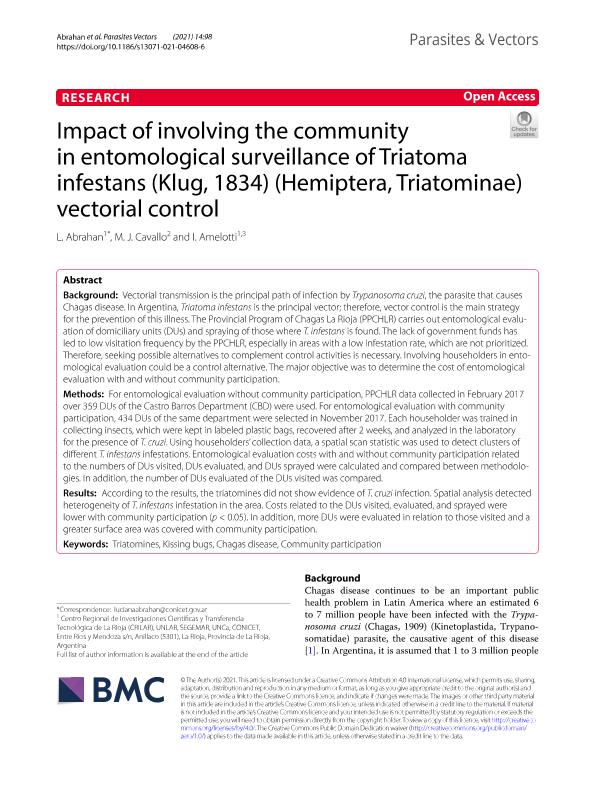Mostrar el registro sencillo del ítem
dc.contributor.author
Abrahan, Luciana Beatriz

dc.contributor.author
Cavallo, María José

dc.contributor.author
Amelotti, Ivana

dc.date.available
2022-08-25T18:52:05Z
dc.date.issued
2021-02-05
dc.identifier.citation
Abrahan, Luciana Beatriz; Cavallo, María José; Amelotti, Ivana; Impact of involving the community in entomological surveillance of Triatoma infestans (Klug, 1834) (Hemiptera, Triatominae) vectorial control; BioMed Central; Parasites and Vectors; 14; 98; 5-2-2021; 1-9
dc.identifier.issn
1756-3305
dc.identifier.uri
http://hdl.handle.net/11336/166654
dc.description.abstract
Background: Vectorial transmission is the principal path of infection by Trypanosoma cruzi, the parasite that causes Chagas disease. In Argentina, Triatoma infestans is the principal vector; therefore, vector control is the main strategy for the prevention of this illness. The Provincial Program of Chagas La Rioja (PPCHLR) carries out entomological evaluation of domiciliary units (DUs) and spraying of those where T. infestans is found. The lack of government funds has led to low visitation frequency by the PPCHLR, especially in areas with a low infestation rate, which are not prioritized. Therefore, seeking possible alternatives to complement control activities is necessary. Involving householders in entomological evaluation could be a control alternative. The major objective was to determine the cost of entomological evaluation with and without community participation. Methods: For entomological evaluation without community participation, PPCHLR data collected in February 2017 over 359 DUs of the Castro Barros Department (CBD) were used. For entomological evaluation with community participation, 434 DUs of the same department were selected in November 2017. Each householder was trained in collecting insects, which were kept in labeled plastic bags, recovered after 2 weeks, and analyzed in the laboratory for the presence of T. cruzi. Using householders' collection data, a spatial scan statistic was used to detect clusters of different T. infestans infestations. Entomological evaluation costs with and without community participation related to the numbers of DUs visited, DUs evaluated, and DUs sprayed were calculated and compared between methodologies. In addition, the number of DUs evaluated of the DUs visited was compared. Results: According to the results, the triatomines did not show evidence of T. cruzi infection. Spatial analysis detected heterogeneity of T. infestans infestation in the area. Costs related to the DUs visited, evaluated, and sprayed were lower with community participation (p < 0.05). In addition, more DUs were evaluated in relation to those visited and a greater surface area was covered with community participation. Conclusion: Participation of the community in the infestation survey is an efficient complement to vertical control, allowing the spraying to be focused on infested houses and thus reducing the PPCHLR's costs and intervention times.[Figure not available: see fulltext.]
dc.format
application/pdf
dc.language.iso
eng
dc.publisher
BioMed Central

dc.rights
info:eu-repo/semantics/openAccess
dc.rights.uri
https://creativecommons.org/licenses/by/2.5/ar/
dc.subject
CHAGAS DISEASE
dc.subject
COMMUNITY PARTICIPATION
dc.subject
KISSING BUGS
dc.subject
TRIATOMINES
dc.subject.classification
Zoología, Ornitología, Entomología, Etología

dc.subject.classification
Ciencias Biológicas

dc.subject.classification
CIENCIAS NATURALES Y EXACTAS

dc.title
Impact of involving the community in entomological surveillance of Triatoma infestans (Klug, 1834) (Hemiptera, Triatominae) vectorial control
dc.type
info:eu-repo/semantics/article
dc.type
info:ar-repo/semantics/artículo
dc.type
info:eu-repo/semantics/publishedVersion
dc.date.updated
2022-08-25T13:45:41Z
dc.identifier.eissn
1756-3305
dc.journal.volume
14
dc.journal.number
98
dc.journal.pagination
1-9
dc.journal.pais
Reino Unido

dc.journal.ciudad
Londres
dc.description.fil
Fil: Abrahan, Luciana Beatriz. Consejo Nacional de Investigaciones Científicas y Técnicas. Centro Regional de Investigaciones Científicas y Transferencia Tecnológica de La Rioja. - Universidad Nacional de La Rioja. Centro Regional de Investigaciones Científicas y Transferencia Tecnológica de La Rioja. - Universidad Nacional de Catamarca. Centro Regional de Investigaciones Científicas y Transferencia Tecnológica de La Rioja. - Secretaría de Industria y Minería. Servicio Geológico Minero Argentino. Centro Regional de Investigaciones Científicas y Transferencia Tecnológica de La Rioja. - Provincia de La Rioja. Centro Regional de Investigaciones Científicas y Transferencia Tecnológica de La Rioja; Argentina
dc.description.fil
Fil: Cavallo, María José. Consejo Nacional de Investigaciones Científicas y Técnicas. Centro de Investigaciones y Transferencia de Catamarca. Universidad Nacional de Catamarca. Centro de Investigaciones y Transferencia de Catamarca; Argentina
dc.description.fil
Fil: Amelotti, Ivana. Consejo Nacional de Investigaciones Científicas y Técnicas. Centro Regional de Investigaciones Científicas y Transferencia Tecnológica de La Rioja. - Universidad Nacional de La Rioja. Centro Regional de Investigaciones Científicas y Transferencia Tecnológica de La Rioja. - Universidad Nacional de Catamarca. Centro Regional de Investigaciones Científicas y Transferencia Tecnológica de La Rioja. - Secretaría de Industria y Minería. Servicio Geológico Minero Argentino. Centro Regional de Investigaciones Científicas y Transferencia Tecnológica de La Rioja. - Provincia de La Rioja. Centro Regional de Investigaciones Científicas y Transferencia Tecnológica de La Rioja; Argentina
dc.journal.title
Parasites and Vectors

dc.relation.alternativeid
info:eu-repo/semantics/altIdentifier/doi/http://dx.doi.org/10.1186/s13071-021-04608-6
dc.relation.alternativeid
info:eu-repo/semantics/altIdentifier/url/https://parasitesandvectors.biomedcentral.com/articles/10.1186/s13071-021-04608-6
Archivos asociados
